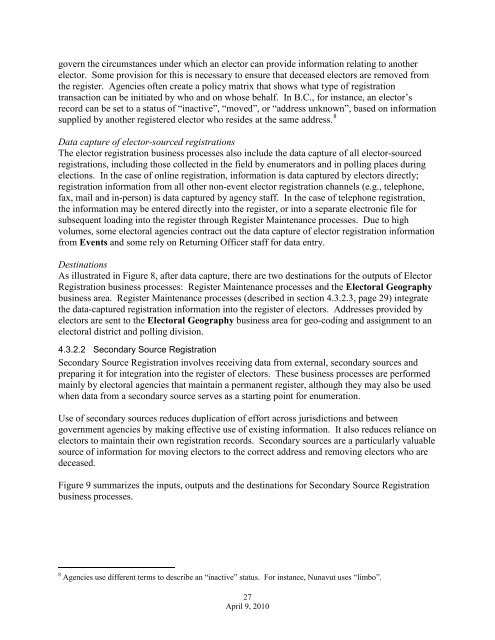Electoral-Management-Reference-Model-v.1.0
Electoral-Management-Reference-Model-v.1.0
Electoral-Management-Reference-Model-v.1.0
You also want an ePaper? Increase the reach of your titles
YUMPU automatically turns print PDFs into web optimized ePapers that Google loves.
govern the circumstances under which an elector can provide information relating to another<br />
elector. Some provision for this is necessary to ensure that deceased electors are removed from<br />
the register. Agencies often create a policy matrix that shows what type of registration<br />
transaction can be initiated by who and on whose behalf. In B.C., for instance, an elector’s<br />
record can be set to a status of “inactive”, “moved”, or “address unknown”, based on information<br />
supplied by another registered elector who resides at the same address. 8<br />
Data capture of elector-sourced registrations<br />
The elector registration business processes also include the data capture of all elector-sourced<br />
registrations, including those collected in the field by enumerators and in polling places during<br />
elections. In the case of online registration, information is data captured by electors directly;<br />
registration information from all other non-event elector registration channels (e.g., telephone,<br />
fax, mail and in-person) is data captured by agency staff. In the case of telephone registration,<br />
the information may be entered directly into the register, or into a separate electronic file for<br />
subsequent loading into the register through Register Maintenance processes. Due to high<br />
volumes, some electoral agencies contract out the data capture of elector registration information<br />
from Events and some rely on Returning Officer staff for data entry.<br />
Destinations<br />
As illustrated in Figure 8, after data capture, there are two destinations for the outputs of Elector<br />
Registration business processes: Register Maintenance processes and the <strong>Electoral</strong> Geography<br />
business area. Register Maintenance processes (described in section 4.3.2.3, page 29) integrate<br />
the data-captured registration information into the register of electors. Addresses provided by<br />
electors are sent to the <strong>Electoral</strong> Geography business area for geo-coding and assignment to an<br />
electoral district and polling division.<br />
4.3.2.2 Secondary Source Registration<br />
Secondary Source Registration involves receiving data from external, secondary sources and<br />
preparing it for integration into the register of electors. These business processes are performed<br />
mainly by electoral agencies that maintain a permanent register, although they may also be used<br />
when data from a secondary source serves as a starting point for enumeration.<br />
Use of secondary sources reduces duplication of effort across jurisdictions and between<br />
government agencies by making effective use of existing information. It also reduces reliance on<br />
electors to maintain their own registration records. Secondary sources are a particularly valuable<br />
source of information for moving electors to the correct address and removing electors who are<br />
deceased.<br />
Figure 9 summarizes the inputs, outputs and the destinations for Secondary Source Registration<br />
business processes.<br />
8 Agencies use different terms to describe an “inactive” status. For instance, Nunavut uses “limbo”.<br />
27<br />
April 9, 2010


